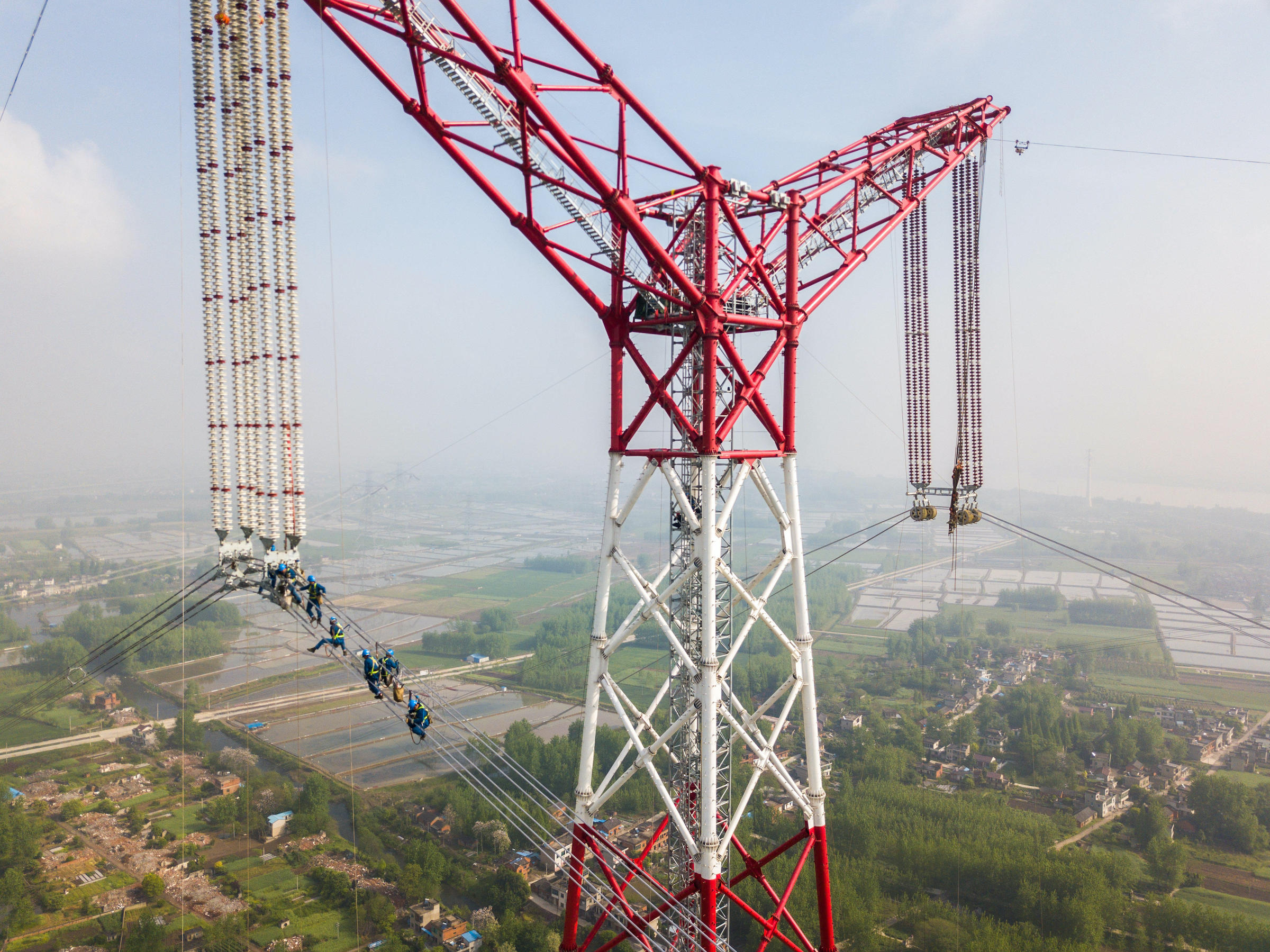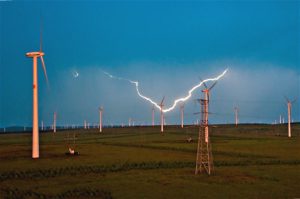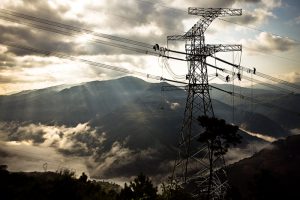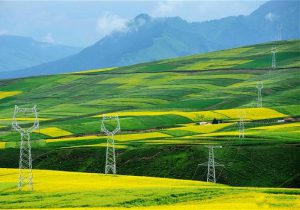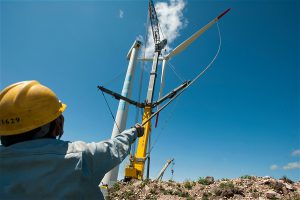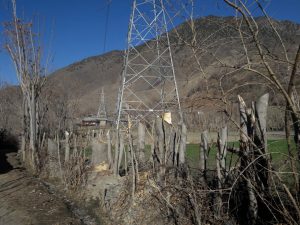China is the global test bed for ultra-high voltage (UHV) transmission lines, a technology that can carry electricity across vast distances with much greater efficiency than the high voltage lines that you’re probably used to seeing.
Since 2006, it’s built 19 of these multi-billion-dollar lines, stretching almost 30,000 kilometres and supplying 4% of national electricity demand. For comparison, no other country has a single UHV line in full commercial operation.
But China’s enthusiasm for UHV is waning. The technology is beset by conflicts of interest between grid companies and central and local governments. The lines themselves are underperforming, and more recent projects are coming online amid a period of electricity generation overcapacity.
This means that approvals for new lines have slowed, and grid companies are unlikely to meet their targets for new ones.
Enlarge map for more detail. Ultra High Voltage line start points are marked in green and endpoints in blue.
Sources: Lantau Group, news reports
Big plans
Chinese grid companies have pursued Ultra High Voltage projects to solve a logistical dilemma: coal, hydro, wind, and solar resources are concentrated in the interior, but the heaviest energy demand is along the urbanised east coast.
In normal high voltage lines, a lot of the power is lost as it’s moved across China’s enormous terrain. The benefit of UHV lines is that they have dramatically reduced losses.
China has deployed two types of UHV line. Direct current (UHVDC) lines suit transmission from A to B over distances of more than 1,000 kilometres; whereas alternating current (UHVAC) lines work better over slightly shorter distances but permit branching links along the way.
Grid companies have been keen adopters, with State Grid, which covers 88% of China’s territory, especially interested. Its 2013-2020 construction plan envisioned six AC and 13 DC lines by 2013, and 10 AC and 27 DC lines by 2020. In Inner Mongolia alone, company officials spoke of 11 lines running from the province’s coal and renewable hotspots by 2020.
But rollouts have slowed, and few analysts expect State Grid will deliver on its 2020 target. In fact, its national UHV backbone scheme, which is the centrepiece of its UHVAC ambitions, looks unlikely to happen anytime soon.
Sparks fly
State Grid’s UHV plans suggested remarkable ambition, but did not always align with those of central and provincial policymakers.
Central officials have clashed with State Grid planners on its backbone scheme, which envisions a lattice of six UHVAC lines to synchronise grids that are currently in State Grid’s territory. But officials worry about nationwide blackouts cascading across these interconnected grids. Analysts suggest that State Grid has shelved the backbone plan for now and is focusing on UHVAC lines within individual grids instead.
Meanwhile, the economic case for new UHVDC lines from the interior has weakened amidst slowing growth in electricity demand.
National demand growth averaged 11.7% from 2003-12 but fell to 4.5% in 2012-17, bottoming out at 0.5% in 2015. This drop has deepened overcapacity in China’s power sector, which according to Bloomberg New Energy Finance was 35% in 2016.
Pervasive overcapacity means less need for new transmission projects.
China’s “Priority Transmission Lines for Air Pollution Prevention”, a scheme announced in 2014 that included the construction of nine UHV lines, is set for completion this year. National Energy Administration (NEA) officials said in December 2017 that this scheme “can satisfy electricity demand for the country’s main power consumption regions before 2020”.
Unsurprisingly, then, approvals for new UHV projects – which take 3-4 years to construct – have been slow, with just one project approved in 2016, and two in 2017.
Local tensions
Certain regional governments targeted for UHV projects have also been sceptical.
Provinces get larger boosts to gross domestic product (GDP), employment, and revenue from building their own power plants rather than importing power from other provinces. Even new lines with central government backing have sometimes failed to get provincial acceptance.
For example, the UHVDC Sichuan Number Four line would take Sichuan hydropower to Jiangxi province, and was singled out for construction in the 13th Five-Year Plan (2016-2020). But as NEA officials noted last autumn, Jiangxi does not want this power. The province is bringing more coal-fired power plants online in 2018 so wants to delay the new line until after 2025. Hubei province is also reluctant to accept long-debated new lines from north-west China.
Disappointing gains
Grid companies have their own reasons for being cautious about new Ultra High Voltage lines. Revenues from these mega-projects depend on the amount of power they can transmit. But utilisation of existing lines has been lower than expected, with non-hydro lines performing particularly badly.
What’s more, the impact of UHV on renewable energy “curtailment” in inland China has also been disappointing, undermining the case for investment. Curtailment refers to energy that never reaches the grid and is wasted, for reasons including a lack of transmission capacity or quotas for coal-power consumption.
China’s UHV lines transmit wind and solar power in combination with coal power, which remains the major electricity source. Nonetheless, even a minority share of UHV transmission capacity can still take sizeable loads of renewables from China’s interior to coastal markets. Backers of UHV lines have jumped on this point when championing the technology.
Yet after a decade of UHV development, renewable curtailment levels remain high, especially in north-western regions. National curtailment rates in 2017 were 12% for wind and 6% for solar, several percentage points below their 2016 peaks. Still, China has room for improvement; in Europe, curtailment rates in countries with high levels of wind-power production have been consistently below 5%.
Analysis by environmental researcher Darrin Magee and geographer Thomas Hennig suggests that in 2015, curtailment in Yunnan reached 95 terawatt hours (TWh) – more than six times the reported rate, and enough to power Portugal and Singapore combined for one year.
Lagging wind and solar
Ultra High Voltage power lines successfully transported 172.5 TWh of renewable energy in 2016, or 3.2% of national power consumption. However, 93% of that power came from five lines used for hydropower only.
Some of China’s non-hydro lines have relied less on renewables than supporters had hoped. Caixin Energy reports that, according to experts at State Grid, renewable shares in lines planned to take a coal-renewable mix should target 30%. Three such lines were in operation for at least part of 2016. Their performance was uneven. Ningdong-Zhejiang carried 29% renewables, and the Southern Hami-Zhengzhou line’s share was at 23%, but Ximeng-Jinan took none at all.
The Zhebei-Fuzhou line was framed initially as a vehicle for nuclear and wind consumption but did not take any wind in 2016. Reports are unclear on whether it has since added wind to its power mix – though it has added coal.
It is hoped that these shortfalls will be temporary. One non-hydro UHV line that launched in 2017 has been relying on coal because the renewable projects planned to accompany it faced construction delays. Overall transmission volumes increased significantly for China’s first UHV lines in their initial five years. Several new UHV lines that take renewables have also come online since mid-2016.
But the shrinking space for new UHVDC projects is a persistent concern for Western provinces, where rapid capacity additions in renewable energy has left long-distance transmission infrastructure struggling to keep pace.
Power sector reforms
UHV is certainly not solely to blame for renewable curtailment problems in the interior. They point to a wider set of challenges facing China’s power sector, which are the focus of reform initiatives launched in 2015. These reforms have included some UHV-specific measures. But many hindrances to the development of UHV lines are best addressed through more comprehensive power sector reforms.
These include power trade markets to make it easier for coastal provinces to buy power from the interior (and locally) at short-notice; measures to strengthen the competitive position of long-distance clean energy against local coal plants; and reforms to reduce disputes around grid planning between central government and provinces.
These reforms are at an early stage. But while enthusiasm for UHV in China is fizzling, the technology will still have a role in the country’s renewable transition. How successful the reforms are will determine what kind of a role that is.
